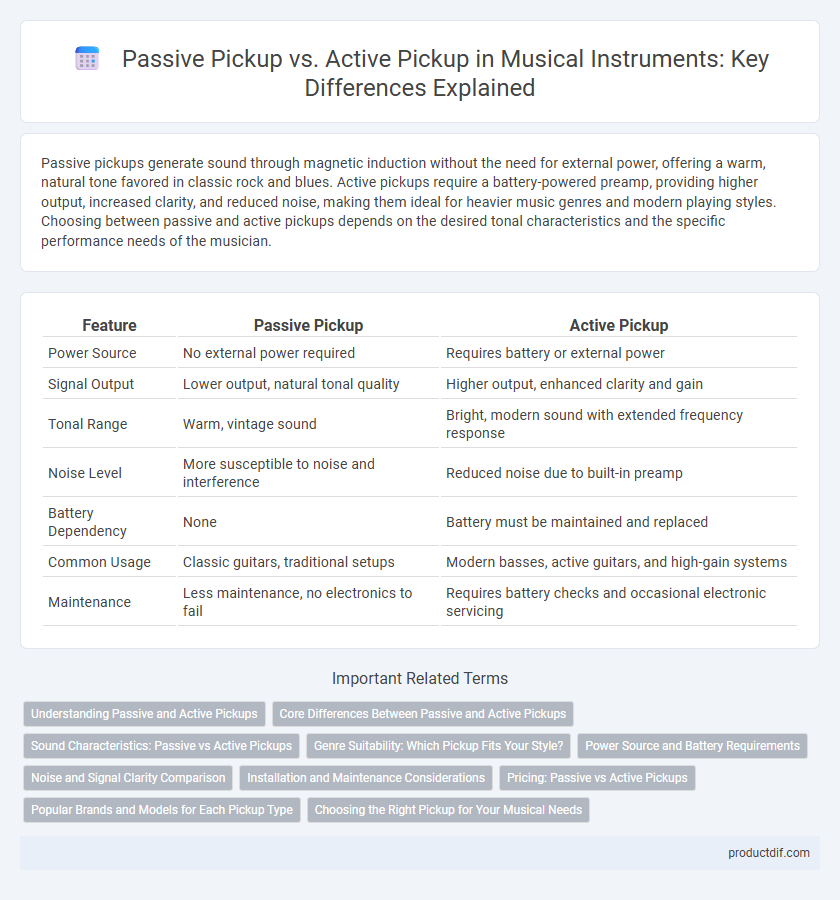Passive pickups generate sound through magnetic induction without the need for external power, offering a warm, natural tone favored in classic rock and blues. Active pickups require a battery-powered preamp, providing higher output, increased clarity, and reduced noise, making them ideal for heavier music genres and modern playing styles. Choosing between passive and active pickups depends on the desired tonal characteristics and the specific performance needs of the musician.
Table of Comparison
| Feature | Passive Pickup | Active Pickup |
|---|---|---|
| Power Source | No external power required | Requires battery or external power |
| Signal Output | Lower output, natural tonal quality | Higher output, enhanced clarity and gain |
| Tonal Range | Warm, vintage sound | Bright, modern sound with extended frequency response |
| Noise Level | More susceptible to noise and interference | Reduced noise due to built-in preamp |
| Battery Dependency | None | Battery must be maintained and replaced |
| Common Usage | Classic guitars, traditional setups | Modern basses, active guitars, and high-gain systems |
| Maintenance | Less maintenance, no electronics to fail | Requires battery checks and occasional electronic servicing |
Understanding Passive and Active Pickups
Passive pickups rely on magnetic induction to convert string vibrations into electrical signals, producing a warm, natural tone favored by many guitarists. Active pickups incorporate an onboard preamp powered by a battery, resulting in higher output, reduced noise, and enhanced tonal clarity, making them ideal for genres requiring more precision and gain. Understanding these differences helps musicians choose the best pickup type for their desired sound and playing style.
Core Differences Between Passive and Active Pickups
Passive pickups rely on magnets and coils to generate a natural, warm tone with dynamic range, whereas active pickups use an onboard battery-powered preamp to boost output and enhance clarity. Passive pickups tend to have lower output and more vintage sound characteristics, while active pickups provide higher output, less noise, and a more consistent, modern tone. The choice between passive and active pickups significantly impacts a guitar's sound, response, and suitability for different music genres.
Sound Characteristics: Passive vs Active Pickups
Passive pickups produce a warm, natural tone with dynamic responsiveness and a wide frequency range, making them ideal for vintage and classic sounds. Active pickups deliver a hotter output with a cleaner, brighter, and more consistent tone, enhanced by an onboard preamp that reduces noise and boosts sustain. The choice between passive and active pickups significantly impacts a guitar's tonal clarity, distortion behavior, and overall sound profile.
Genre Suitability: Which Pickup Fits Your Style?
Passive pickups deliver a warm, vintage tone ideal for genres like blues, classic rock, and jazz due to their natural dynamic response and organic sound. Active pickups, equipped with onboard preamps, provide higher output and clarity, making them perfect for heavy metal, hard rock, and modern genres that require aggressive distortion and precise articulation. Choosing between passive and active pickups hinges on your musical style and the tonal characteristics needed to enhance your playing and genre-specific sound.
Power Source and Battery Requirements
Passive pickups operate without an external power source, relying solely on the magnetic field generated by the strings to produce sound. Active pickups require a battery, typically a 9-volt, to power an onboard preamp that boosts signal output and enhances tonal clarity. Battery maintenance is crucial for active pickups to prevent signal loss and ensure consistent performance.
Noise and Signal Clarity Comparison
Passive pickups generate a warmer, natural tone but are more susceptible to electromagnetic interference, resulting in higher noise levels and lower signal clarity in complex environments. Active pickups incorporate an onboard preamp powered by a battery, which boosts output signal strength and significantly reduces noise, providing clearer and more consistent tonal quality. Noise rejection in active pickups improves clarity, especially when using effects pedals or long cable runs, making them ideal for high-gain setups.
Installation and Maintenance Considerations
Passive pickups generally require simpler installation as they use fewer components and do not need a power source, making them easier to wire and maintain for most guitar players. Active pickups, containing built-in preamps powered by batteries, need careful battery compartment placement and periodic battery replacement, which adds complexity to both installation and ongoing maintenance. Proper shielding and wire management are critical for active pickups to prevent noise interference, while passive pickups typically demand less frequent troubleshooting.
Pricing: Passive vs Active Pickups
Passive pickups generally cost less than active pickups due to simpler construction and lack of onboard preamps, making them budget-friendly for beginners and traditionalists. Active pickups include built-in preamps that require batteries, increasing manufacturing complexity and price, often targeting professional musicians seeking higher output and clarity. Pricing for passive models typically ranges from $30 to $100, while active pickups often start around $100 and can exceed $200 depending on brand and technology.
Popular Brands and Models for Each Pickup Type
Passive pickups dominate classic guitar models from Fender, such as the Stratocaster and Telecaster, renowned for their warm, vintage tones. Gibson's Les Paul typically features passive humbuckers, prized for thick, expressive sound. In contrast, active pickups, found in brands like EMG and Fishman Fluence, power modern designs favored by metal and hard rock players for their high output and low noise levels.
Choosing the Right Pickup for Your Musical Needs
Passive pickups offer a warm, natural tone favored for vintage and blues styles due to their simpler design and reliance on magnet strength, making them ideal for traditional sonic preferences. Active pickups provide higher output and enhanced clarity, often incorporating built-in preamps that suit genres requiring clean, powerful sounds such as metal and modern rock. Selecting the right pickup depends on your musical style, desired tone, and amplifier compatibility to achieve optimal performance and sound quality.
Passive pickup vs Active pickup Infographic

 productdif.com
productdif.com